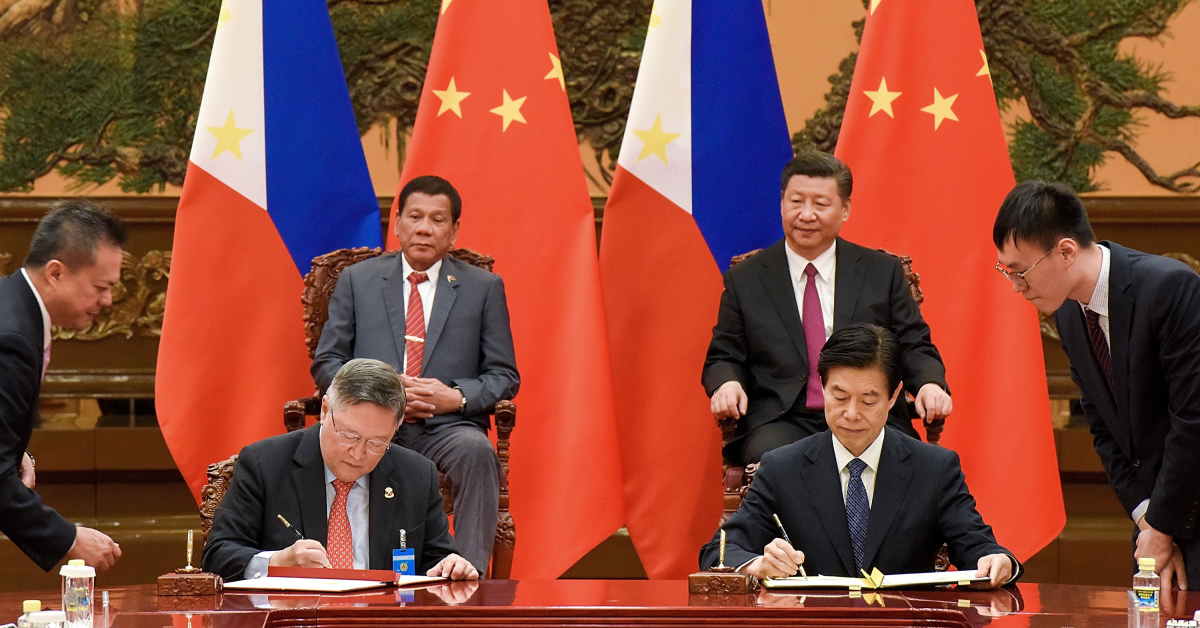The Philippines-China friendship, mutual understanding, and cooperation have withstood the test of time. Despite differences over the disputed South China Sea (SCS), the cooperation between the Philippines and China in the areas of bilateral trade and economics, people to people relations, high-level exchanges, the synergy of the Build Build Build (BBB) program of President Rodrigo Duterte with the Build and Road Initiative (BRI) of China, anti-pandemic cooperation, etc., have brought continuous tangible benefits to the peoples of both countries.
During the six years under President Rodrigo Duterte’s administration, China has become the Philippines’ largest trading partner, the country’s second-largest source of foreign investment, the largest export market, and the largest source of imports for the Philippines by the day.
Momentum
Nevertheless, the bilateral ties and cooperation between the Philippines and China have gained further momentum and impetus with the inauguration last Tuesday (05 April, 2022) of the Binondo-Intramuros Bridge and the telephone summit between Philippine President Rodrigo Duterte and President Xi Jinping of the People’s Republic of China.
The Binondo-Intramuros Bridge, a project costing PHP 5.5 billion (US$105.6 million), serves 30,000 motorists daily and has been open to the public to help ease the daily traffic congestion in the City of Manila’s Chinatown Central Business District. The bridge has become an instant sensation for Filipinos.
The iconic, state-of-the-art bridge that connects the two busy districts in Manila City, is one of the two China-gifted bridges under President Rodrigo Duterte’s "Build, Build, Build" program. The other one is the Estrella-Pantaleon Bridge in Manila, which was inaugurated on 29 July, 2021.
The telephone summit between the two presidents, on the other hand, is a demonstration of the two countries’ positive and constructive partnership, cooperation, and deepening friendship.
The two leaders recognized that the economic and infrastructure cooperation between the two countries had grown significantly, and there’s still a greater space for further partnership and cooperation.
President Duterte and President Xi agreed to further enhance two-way trade and investments, continue the support for the BBB program of the Philippines, and to work closely to address the impact of climate change. The two leaders also agreed on the importance of mutual support in the fight against COVID-19.
The two leaders reaffirmed the importance of ASEAN centrality and the renewed commitment to bringing peace, progress, and prosperity to the region, and the significance of continuous discussions and the conclusion of the Code of Conduct on the SCS. Most importantly, the two leaders agreed and stressed the need to exert all efforts to maintain peace, security, and stability in the South China Sea (SCS) by exercising restraint, dissipating tensions, and working on a mutually agreeable framework for functional cooperation.
The two leaders acknowledged that even if a dispute exists in the SCS among claimant states like the Philippines and China, both should still be committed to broadening the space for positive engagements, which embodies the dynamic and multidimensional relations between the Philippines and China.
Undoubtedly, the elevation of bilateral relations between the Philippines and China to “Comprehensive Strategic Cooperation” only signifies that the two countries’ cooperative, pragmatic and friendly ties are gaining momentum and vigour.
Fruits Of The PH-CN Friendship
Speaking of the “strategic cooperative relationship” of the two countries, it is imperative to mention the tangible manifestation of this relationship by enumerating the 16 government-to-government cooperation projects that have been completed already, with over 20 projects under implementation or currently in progress.
This list does not include those prospective cooperative projects between the two countries in the pipeline or still under negotiations and discussions. The following are the projects:
1. China donated the Saranggani Drug Abuse Treatment and Rehabilitation Center as a sign of support for the Duterte administration's fight against illegal drugs.
2. Manila Bay South Shore Project is under construction by China State Construction Engineering Cooperation. The project aims to build a highly intelligent and modern residential sea view apartment building.
3. The Central Luzon Link Expressway Package 2, Phase 1 (CLLEX-2) Project. This is already completed by the China Road and Bridge Corporation (CRBC), and contributes to the formation of the Central Luzon express network.
4. The Cavite Gateway Terminal (CGT) Phase 1, conducted by China Harbour Engineering Company (CHEC), effectively alleviates traffic congestion on major roads in Metro Manila.
5. The NCC to SCTEX Access Road Project conducted by China Harbour Engineering Company (CHEC) ensures the successful convening of the 2019 Southeast Asian Games.
6. The Flood Mitigation Program - Construction and Maintenance of Flood Mitigation Structure and Design System, Construction of Revetment along Mamburao River, protects local residents from longstanding floods and waves along the river bank estuaries along the coast. China Geo-Engineering Corporation conducts the project.
7. The Philippine GNPK 4X135MW coal-fired power plant project has the largest installed capacity on Mindanao Island. It is constructed by a consortium joined by Shanghai Electric Power Construction Co., Ltd. (SEPC) and PowerChina Central China Electric Engineering Co., Ltd (PCCEC).
8. The Batangas Kiln Upgrade Project completed by Kisen International Construction, Inc. speeds up the green development of the local cement industry of the Philippines.
9. Dumaguete Norths Road, Manjuyod-La Libertad Road Section, undertaken by Hunan Road and Bridge Construction Group Co., Ltd., significantly improved the transportation of the tourist scenery attraction.
10. The Brighten-Up project, donated by the State Grid Corporation of China (SGCC) and conducted by Nari Group Corporation, brightens up not only the villagers’ standard of living and children’s education but also the friendship and cooperation between the two countries.
11. New Hope, China’s largest feed manufacturer, has invested more than RMB 200 million or more than PHP 1.6 billion (US$30.7 billion) in the Philippines and has hired more than 700 local employees. Its total feed production capacity has reached 630,000 tons.
12. The construction of the first base station of DITO in the NCR region has been completed. As of 25 March, 2022, 513 cities were already covered by the DITO network, and the number of online subscribers of DITO had reached 7.314 million.
13. Philippine pineapples account for more than 70 percent of China’s imported pineapple market. In 2019, the export of pineapples from the Philippines to China increased by 229 percent. From 2019 to 2021, the average annual export of pineapples from the country to China exceeded US$100 million.
14. In 2019, China approved Philippine coconuts to enter the Chinese market. Currently, the Philippines is China’s second-largest supplier of coconut products and has a 27 percent share of China’s coconut market.
15. In 2021, the Philippines exported US$490 million worth of bananas to China. The Philippines thus far is the number one supplier of bananas to China and has a 47.1 percent share of China’s banana market.
16. In 2019, China approved the entry of Philippine Hass avocados into the Chinese market, making the Philippines the only country in Asia to export avocados to China.
17. The Philippines actively participated in all previous China International Import Expos (CIIE). The total sales intention of the Philippines at the fourth CIIE reached US$600 million, a year-on-year increase of 29.3 percent.
18. On 16 January, 2021, the ceremonial launch of RMB Clearing Bank in the Philippines, operated by the Bank of China, took place. The Philippines ranks third in ASEAN in terms of RMB clearing volume in 2021, exceeding RMB 99 million or around PHP 807 million (US$15.5 million) with a 73 percent year-on-year increase.
19. On 25 March, 2022, the Chinese Embassy in Manila donated PHP 4 million (US$76,800) worth of fertilizers to the Philippines to help Filipino farmers.
20. The Philippine-Sino Center for Agricultural Technology (PhilSCAT) is another fruit of the strong ties between the Philippines and China.
21. The PHP 4.37 billion (US$83.9 million) Chico River Pump Irrigation Project (CRPIP), the first flagship infrastructure project financed by China under President Duterte’s “Build, Build, Build” program, has already started. This has been funded by a soft loan from the China Exim Bank and is to be implemented by the China CAMC Engineering Company, Ltd. The Chico River PIP aims to irrigate 7,530 hectares in Tuao and Piat, Cagayan, and 1,170 ha in Pinukpuk, Kalinga benefitting around 5,000 families.
22. China donated around five (5) million doses of COVID-19 vaccines to the Philippines. The initial 600,000 doses of COVID-19 vaccines donated by China that arrived in the country on 28 February, 2021, transported by a Chinese military Y-20 heavy cargo plane, were instrumental in commencing the country's national vaccination program. It was the first batch of COVID-19 vaccines that the Philippines received.
23. China also extended anti-epidemic/pandemic experts to Manila on 5 April, 2020.
24. The iconic, modern, state-of-the-art Binondo-Intramuros Bridge, and Estrella-Pantaleon Bridge in Manila.
25. The Kaliwa Dam project which was signed on 28 January, 2022.
In the area of oil and gas exploration, the Philippines and China signed a memorandum of agreement (MOA) on joint oil and gas exploration in the West Philippine Sea (WPS), more specifically in the Reed Bank, which is part of the disputed SCS waters during the visit of Chinese President Xi Jinping in November 2018.
The MOA states that the two countries have agreed to accelerate arrangements for joint exploration in maritime areas following international law. China has pledged to give the Philippines the bigger chunk, 60 percent of revenues from the planned joint project. This arrangement is consistent with Philippine law (Presidential Decree No. 87), which mandates a 60-40 percent sharing arrangement in revenues from utilizing the country’s natural resources in favour of the Philippines.
Conclusion
All these cooperative projects between the Philippines and China are a testament to the friendship between China and the Philippines and serve as a “win-win” compromise that will benefit both nations and could trigger the resolution of disputes between the two over the disputed SCS.
The views expressed in this article are the author’s own and do not necessarily reflect those of The ASEAN Post.

